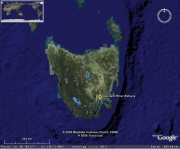Seastar mass
Type of resources
Topics
Keywords
Contact for the resource
Provided by
Years
-

In the Derwent Estuary (south eastern Tasmania, Australia), the introduced northern Pacific seastar Asterias amurensis is highly abundant and fecund when associated with anthropogenic structures (wharves and marinas). Based on modelled predictions of fertilisation success, seastars at wharf 'hotspots', whilst representing <10% of the total population in the Derwent Estuary, and concentrated in <0.1% of the total area, contribute up to >80% of total larval production in the estuary. Reproductive potential of populations at wharf and control sites was quantified (in terms of individual capacity and spatial characteristics of the population. A large scale survey was undertaken in the Derwent estuary (to 27m) to determine spatial distribution of the species. Zygote production (i.e. number of fertilised eggs) was used as a measure of reproductive output and was simulated using empirical estimates of spatial and reproductive parameters of the adult seastars in a spatially explicit model of fertilization (developed by A. Morris and C. Johnson).
 IMAS Metadata Catalogue
IMAS Metadata Catalogue